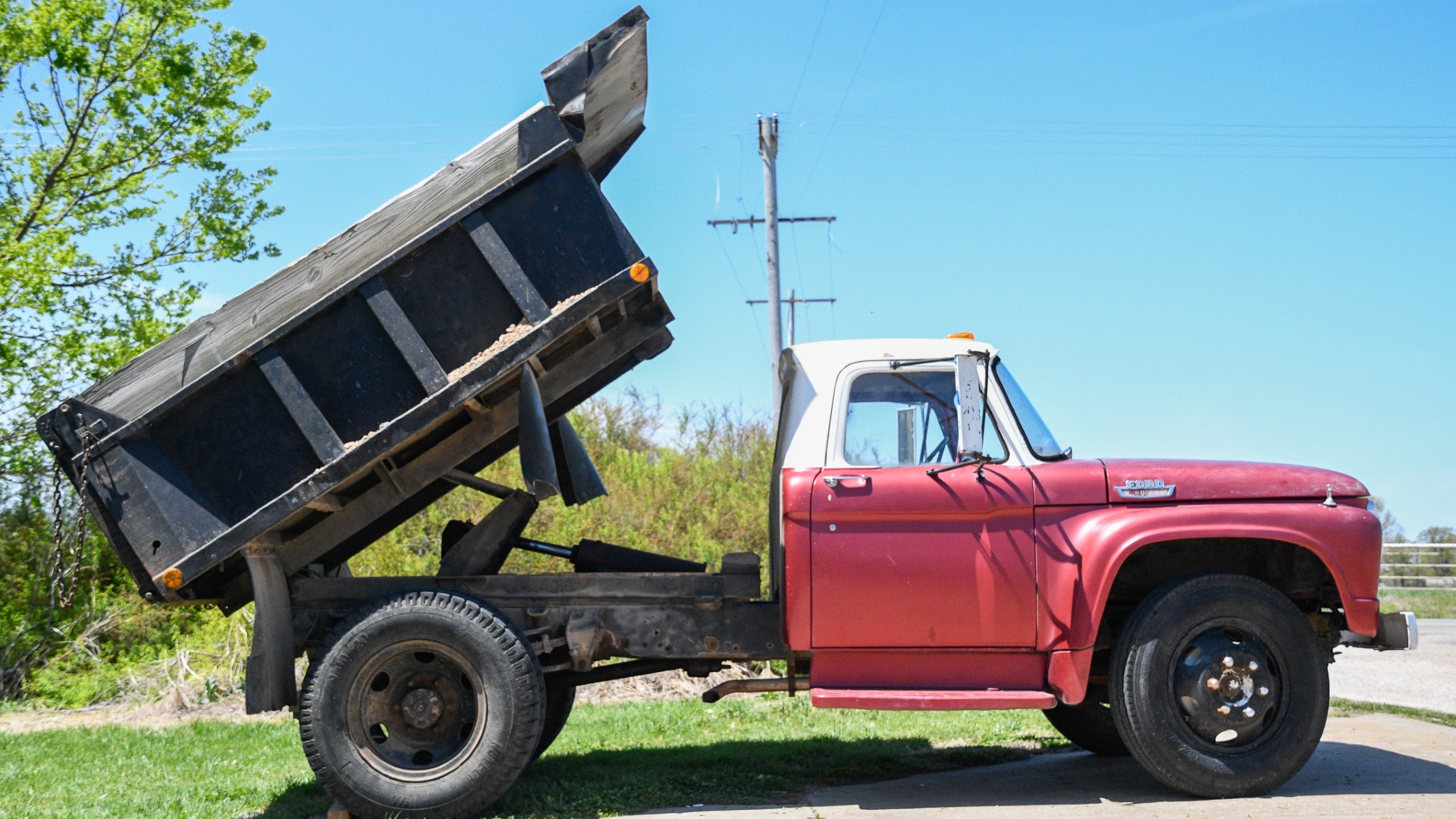

We may earn revenue from the products available on this page and participate in affiliate programs. Learn more ›
New-age dually pickups boast mighty diesel engines with 400-plus horsepower and more than 1,000 pound-feet of torque, helping them tow upwards of 30,000 pounds via gooseneck or fifth-wheel trailers. My 1966 Ford F600 is…not like that. Its 300-cubic-inch inline-six makes only 150 net horsepower and 272 pound-feet of torque, but it can still haul more than 11,000 pounds in the bed. Most modern Super Duty DRW models you see on the road max out around 7,000 pounds of payload capacity, so how does mine manage?
Frame, suspension and axle strength all play a part, as does gearing.

Know Your Truck
I want to clear this up right away: gross vehicle weight ratings and, resultantly, vehicle classification make all the difference. Despite contemporary F-350s having much more powerful engines, they still fall on the lighter side of medium-duty trucks with 11,xxx-pound GVWRs, landing them squarely in Class 3. My truck has a listed GVWR of 20,000 pounds, making it a Class 6; for the sake of comparison, a 2020 F-600 has a GVWR of 22,000 pounds and consequently a payload capacity nearly two tons higher than my classic.
GVWR can be attributed to frame strength, suspension toughness and axle capacities, among other factors. It’s essentially the weight that your vehicle can withstand, including the heft of the truck itself. This is determined and listed by the manufacturer, though you can have some insight into how your vehicle’s was set by looking at attributes such as axle rating. For example, according to my door tag, my Ford has an Eaton 13802 rear axle, which carries a rating of 15,000 pounds.
One method of calculating a rough payload capacity estimate is to take the vehicle’s measured weight and subtract it from the GVWR. In the case of my 1966, it weighs 8,500 pounds empty, so subtracting that from the 20,000 GVWR gives me about 11,500 pounds of potential payload capacity.
It’s important to note that GVWR excludes rated trailer weight; that’s designated by another figure assigned by the manufacturer known as gross combined weight rating, or GCWR. In that category, my Ford is far outweighed by duallies from this century.
In layman’s terms, a new F-350 with the 6.7-liter Power Stroke diesel may have enough power to lug around 11,000 pounds in the bed, but the frame and suspension system ain’t made for it. Therefore, if you’re planning on hauling cargo without a trailer, you’ll want to step up.

Gearing Makes the World Go ‘Round
I may be able to carry 5.5 tons of gravel in my truck’s dump bed with (relatively few) issues, but I can’t push the 55-year-old rig past 60 miles per hour without a fight or a death wish. Modern trucks are far more eager to cruise on the interstate with plenty of passing power left at 70 mph, empty or fully loaded. Everything has its trade-off and, in my case, it’s speed. Oh, and comfort. And safety.
Since my F600 has an electric two-speed rear end, I’ve got the option of a 5.83 or 8.11 axle ratio in high and low, respectively. Essentially, the axle ratio is how many revolutions it takes for the output shaft from the transmission to turn the ring and pinion gears inside the rear end precisely once. Power is then dispersed through the axle shafts and to the vehicle’s wheels. The more times that output shaft has to turn to spin the rear wheels once, the higher the number—and the “lower” the rear end is considered to be.
So, the lowest available rear end in a 2020 Ford F-350 has a 4.30 ratio, which is plenty low by most folks’ standards but quite a bit higher than my patina’d prince. A new F-600, meanwhile, has 4.88 rears. This is where I come out ahead.
With my transmission in granny low and the two-speed switch depressed, I’m not going anywhere quicker than about 7 mph. Even then, the engine would be spinning around 4,000 rpm which I assure you is plenty. This comes in handy when you’ve got to climb a steep grade such as a driveway with a load on. Beyond that, making full use of my eight forward speeds (four-speed transmission multiplied by the two-speed axle) is crucial to keeping up with traffic.
Gearing can make all the difference in how a vehicle performs, which is why you see hot-rodders and off-roaders swap rear ends and differentials to better fit their application. There’s an almost infinite number of adjustments that can be made within a transmission and differential to extract the most performance or efficiency out of an engine. My truck happens to fit in the former category given its teensy power output but relatively big-time work capabilities.

To Swap or Not to Swap
I’ve considered swapping a more powerful engine into my Ford, but truthfully, there’s no need. Most of the hauling I do is at low speeds and, frankly, the inline-six has no problem taking off from a standstill. Peak torque kicks in at 1,400 rpm and carries on to 2,100 rpm, a range where I spend a lot of my time when moving creek gravel at our family’s campground.
Still, no one could blame you for putting a more modern turbodiesel like a 12-valve Cummins into yours. Just know you probably don’t need it.

Caleb Jacobs is Deputy News Editor at The Drive. He buys weird things, like a ’66 Ford dump truck, a ’65 Chevy school bus and a ’63 International Loadstar. We can’t seem to stop him from writing about them. Send him a note: caleb@thedrive.com